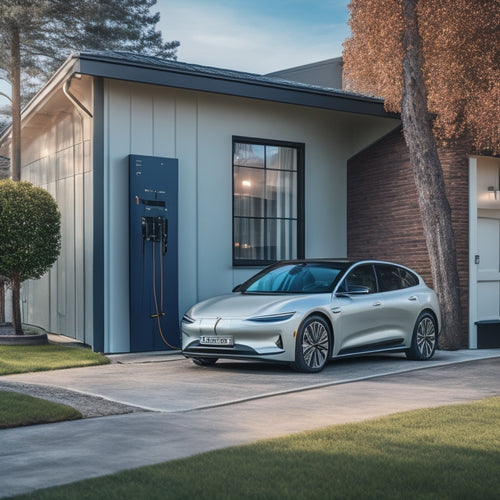
Why Advanced Battery Design Matters for EVs
Share
As you consider purchasing an electric vehicle, you're likely aware that battery design plays a pivotal role in your driving experience. Advanced battery design is essential for achieving longer ranges, faster charging, and increased sustainability. It's about enhancing energy density through innovative materials and thermal management breakthroughs. You'll benefit from reduced range anxiety with strategic charging infrastructure placement and optimized route planning. Additionally, sustainable battery materials, cost-effective design innovations, and faster charging technologies are all part of the equation. Now, as you explore the intricacies of advanced battery design, you'll uncover the secrets to maximizing the full potential of EVs.
Key Takeaways
• Advanced battery design is crucial for increasing energy density, reducing range anxiety, and enhancing overall EV performance.
• Innovative thermal management systems regulate temperature fluctuations, ensuring safe and efficient battery operation.
• Sustainable battery materials and eco-friendly electrolyte solutions minimize environmental impact, reducing waste and toxicity.
• Faster charging technologies, like power sharing and smart grids, reduce waiting times and increase charging efficiency.
• Cost-effective design innovations, such as modular architectures and standardized components, enhance scalability and reduce production costs.
Enhanced Energy Density Matters
As you explore the world of electric vehicles, you'll find that advanced battery design pivots on one essential aspect: improved energy density, which directly impacts the overall range and performance of EVs.
To achieve this, material innovations play a critical role. Researchers are developing new materials with higher energy density, allowing for more efficient energy storage. For instance, advancements in lithium-ion battery technology have led to the development of high-energy density cathode materials, enabling EVs to travel farther on a single charge.
Another important factor is dimensional scaling. By scaling down battery components, manufacturers can increase energy density while reducing the overall size of the battery. This is achieved through the use of advanced nanomaterials and 3D architectures, which enable more efficient energy storage and release.
By combining material innovations with dimensional scaling, EV manufacturers can create batteries that aren't only more efficient but also more compact, making them ideal for electric vehicles.
As you explore further into the world of EVs, it's evident that advanced battery design is essential for improving range and performance.
Range Anxiety Reduction Strategies
As you explore ways to alleviate range anxiety, you'll find that three key strategies stand out:
expanding charging infrastructure to reduce uncertainty,
optimizing route planning to minimize detours, and
monitoring battery health to guarantee peak performance.
By implementing these strategies, you can greatly reduce the stress associated with running out of juice on the road.
Charging Infrastructure Expansion
Expanding charging infrastructure is vital to alleviate range anxiety, a significant hurdle in widespread EV adoption, by providing you with convenient and reliable access to charging stations along highways and in urban areas. As you consider switching to an electric vehicle, you'll want to know that charging infrastructure expansion is essential to your driving experience.
Urban planning plays an important role in determining station placement, ensuring that charging points are strategically located near high-traffic areas, such as shopping centers and public parking lots. Additionally, grid resilience and power distribution systems must be upgraded to accommodate the increased demand for electricity. This not only supports the growth of EV adoption but also improves overall grid efficiency.
To further alleviate range anxiety, rural accessibility must be prioritized, providing you with a seamless charging experience regardless of your location. Public education campaigns can also help raise awareness about the expanding charging network, promoting confidence in EV ownership.
Route Planning Optimization
By incorporating advanced route planning optimization into your EV's navigation system, you can greatly reduce range anxiety by identifying the most energy-efficient routes and locating convenient charging stations along your journey. This cutting-edge technology takes into account real-time traffic patterns, road conditions, and your vehicle's energy consumption to provide the most efficient route possible.
By prioritizing routes with minimal stops, fewer traffic lights, and optimized acceleration, you can conserve energy and extend your driving range. Moreover, route planning optimization can also identify charging stations with the shortest wait times, ensuring that you can recharge quickly and get back on the road.
With advanced route planning, you'll be able to plan your trips with confidence, knowing that you'll arrive at your destination with a comfortable margin of safety. By minimizing range anxiety, you can focus on enjoying the drive, rather than worrying about running out of juice.
Battery Health Monitoring
Your vehicle's advanced battery health monitoring system closely observes your battery's state of charge, voltage, and temperature to guarantee you're always aware of its condition, enabling you to plan your route and charging stops with confidence.
This advanced monitoring system utilizes sophisticated algorithms to detect even the slightest anomalies, ensuring your safety and preventing unexpected battery failures. It's equipped with fault detection capabilities, which identify potential issues before they become major problems, allowing you to take corrective action promptly.
Additionally, the system employs cell balancing techniques to ensure individual cells are operating within ideal parameters, preventing uneven wear and tear. This precise monitoring enables you to drive with confidence, knowing your battery's health is being constantly monitored.
With real-time data at your fingertips, you can make informed decisions about when to charge, how far you can drive, and what routes to take. By keeping a close eye on your battery's health, you can mitigate range anxiety and enjoy a seamless driving experience.
Thermal Management Breakthroughs
Advanced battery designs are leveraging innovative thermal management breakthroughs to regulate temperature fluctuations, ensuring peak performance and prolonged lifespan in electric vehicles.
You're probably wondering how this magic happens. The answer lies in cutting-edge cooling systems and heat shields that prevent overheating.
These advanced thermal management systems are designed to dissipate heat efficiently, ensuring that your EV's battery operates within a safe temperature range. This is essential, as excessive heat can lead to reduced battery life and even safety hazards.
By incorporating advanced materials and clever design, these systems minimize heat buildup, allowing your EV to perform at its best.
For instance, some cooling systems utilize advanced airflow management to direct cooling air precisely where it's needed, while others employ phase-change materials to absorb and release heat as needed.
Heat shields, on the other hand, provide an additional layer of protection, deflecting heat away from sensitive components.
Faster Charging Technologies Ahead
What's holding you back from taking your EV on a road trip: the time it takes to recharge? You're not alone. Faster charging technologies are being developed to alleviate range anxiety and make long-distance EV travel a breeze.
One promising solution is power sharing, where multiple vehicles can charge simultaneously from a single, high-power charger. This approach not only reduces waiting times but also increases the overall efficiency of the charging process.
Smart grids are also playing a vital role in accelerating EV adoption. By intelligently managing energy distribution, smart grids can direct excess energy to charging stations, making it possible to charge your EV quickly and efficiently. With the ability to dynamically adjust power output, smart grids can make sure that charging infrastructure keeps pace with the growing demand for EVs.
As the technology continues to advance, you can expect to see faster, more convenient charging options popping up along highways and in urban centers, making long-distance EV travel a more practical and appealing option.
Sustainable Battery Materials Used
As you explore the world of sustainable battery materials, you'll discover a range of eco-friendly options that can transform the EV industry.
From cathode materials that reduce environmental impact to anode materials that prioritize recyclability, the possibilities are vast.
Eco-Friendly Cathode Options
How will you guarantee that the cathode materials in your EV battery are eco-friendly and sustainable, considering the environmental impact of the entire lifecycle of the battery? This is a critical question, as traditional cathode materials like lithium cobalt oxide have notable environmental drawbacks.
One promising solution is lithium reduction, which involves reducing the amount of lithium used in cathode production. This approach not only decreases lithium mining's environmental impact but also reduces the battery's overall cost.
Another approach is to explore Manganese alternatives, which are more environmentally friendly than traditional cobalt-based cathodes. Manganese-based cathodes offer improved recyclability and reduced toxicity, making them an attractive option for eco-conscious EV manufacturers.
Sustainable Anode Materials
You can further minimize your EV battery's environmental impact by exploring sustainable anode materials that reduce waste and energy consumption during production, such as graphite alternatives like silicon and lithium titanate. These alternatives offer improved performance and reduced environmental footprint. For instance, silicon-based anodes have shown higher energy density and longer cycle life compared to traditional graphite anodes.
| Anode Material | Properties |
|---|---|
| Graphite | High energy density, low cost, but high environmental impact |
| Silicon | High energy density, improved cycle life, reduced environmental impact |
| Lithium Titanate | Low cost, improved safety, reduced environmental impact |
| Nanostructured Carbon | High energy density, improved power density, reduced environmental impact |
| Hard Carbon | High energy density, improved cycle life, reduced environmental impact |
In addition, nanostructured architectures can be designed to enhance the performance of these sustainable anode materials. By designing nanostructured materials with optimized morphology and surface area, you can improve the electrochemical performance and reduce the environmental impact of your EV battery.
Green Electrolyte Solutions
Optimizing electrolyte solutions with sustainable materials is vital for reducing the environmental footprint of EV batteries, and researchers have made significant strides in developing novel, eco-friendly electrolyte formulations that minimize waste and toxicity.
As you explore the world of green electrolyte solutions, you'll uncover innovative approaches that prioritize sustainability. One promising area of research involves the use of biodegradable solvents, which can reduce the environmental impact of electrolyte production. These solvents are designed to break down naturally, eliminating the need for hazardous waste disposal.
Another important aspect of sustainable electrolyte design is recycling. You'll find that researchers are investigating closed-loop systems where spent electrolytes can be collected, refurbished, and reused. This closed-loop approach minimizes waste, reduces the demand for raw materials, and decreases the energy required for production.
Cost-Effective Design Innovations
As you explore the world of advanced battery design, you'll discover that cost-effective innovations can make all the difference.
Modular architectures, for instance, allow for the standardization of components, reducing production costs and enhancing scalability. By adopting modular designs, manufacturers can simplify their production processes, minimize waste, and optimize resource allocation. This, in turn, enables them to pass the cost savings on to consumers, making EVs more competitive with traditional gas-powered vehicles.
Integrated systems are another key area of innovation. By combining multiple functions into a single, compact unit, designers can reduce the overall weight and complexity of the battery pack. This not only saves on materials and manufacturing costs but also enhances the overall performance and reliability of the battery.
As you explore further into the world of advanced battery design, you'll uncover many more cost-effective innovations that are driving the EV revolution forward.
Frequently Asked Questions
Can Advanced Battery Design Reduce Electric Vehicle Production Costs?
You'll find that advanced battery design can indeed reduce electric vehicle production costs, yielding significant cost savings through economies of scale, making EVs more competitive in the market and increasing their adoption.
How Do Thermal Management Systems Impact Battery Lifespan?
As you explore the world of EVs, you'll find that thermal management systems are the unsung heroes, ensuring cell balancing and heat mitigation to prolong battery lifespan, and you'll discover that a well-designed system can add up to 10% more miles to your EV's range.
Will Advanced Battery Design Make EVS More Environmentally Friendly?
You'll find that advanced battery design greatly reduces the carbon footprint of EVs by incorporating sustainable manufacturing, eco-friendly materials, and green technologies, ultimately making them more environmentally friendly and aligning with your values.
Can Advanced Battery Design Improve EV Performance in Extreme Temperatures?
You might wonder if advanced battery design can overcome temperature-related performance issues. Thankfully, yes - thermal resilience in cold climates improves, allowing your EV to maintain its range and efficiency even in freezing conditions.
Will Advanced Battery Design Enable Longer EV Warranties?
You'll likely see longer EV warranties with advanced battery design, as it enhances battery reliability, allowing manufacturers to confidently offer warranty extensions, providing you with added peace of mind and protection for your investment.
Related Posts
-

Why You Need a Phone Mount for Navigation
When you're on the road, a reliable phone mount is not just a convenience, it's a safety necessity that helps you mai...
-

5 Essential Tips for Buying EV Charging Systems Online
When purchasing an EV charging system online, you'll want to make sure you're making an informed decision. First, det...
-

3 Best State and Local Solar Incentives USA
You can greatly reduce your energy dependence and save thousands of dollars by taking advantage of the top state and ...


